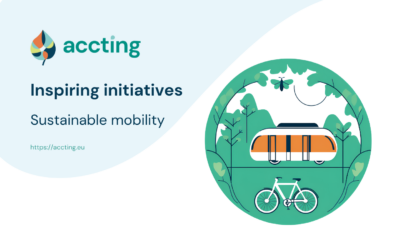Where are the Women in Forest Fire Response? Women Firefighters and Village Heads of Izmir, Turkey
Esin Düzel, Ayşe Gül Altınay, Burcu Borhan Türeli
Forest fires are becoming an increasingly urgent crisis, threatening ecosystems, livelihoods, and communities worldwide. But when we think about those on the frontlines—preventing fires, responding to emergencies, and leading recovery efforts—women’s contributions often go unnoticed. How do women prevent and stop forest fires, and how do they contribute to the recovery process? Where does women’s labor stand in forest fire intervention? Over the course of our three-and-a-half-year research, we have identified that women take on significant responsibilities and play critical roles in forest fire prevention and response. However, public and civil society institutions working in this field often overlook the work that women are already doing. Yet, it is possible to build a more effective forest fire response system by drawing inspiration from women, positioning them as key actors in the process, and developing a gender-responsive approach to fire prevention.
As the ACCTING project, we have been researching the impact of green transition policies on vulnerable groups since 2022. As the Sabanci University (Turkey) team, our focus has been on forest fires within the broader disaster research stream. In the study, while our colleagues in Portugal have studied the impacts of floods and fires on vulnerable communities, in Italy the focus has been on floods, and our colleagues in Sweden have investigated wildfires and the broader impacts of the climate crisis unfolding as “slow disasters.”
All of these studies point to a common finding: institutions responsible for disaster response recognize the growing importance of preparedness as natural disasters increase in frequency and severity due to the deepening climate crisis. However, the measures they implement often overlook or only minimally engage with local knowledges and experiences, failing to involve local communities in the process. Too often, disaster preparedness strategies are implemented through a top-down approach and overly focused on technological solutions. Local groups—such as villagers, neighborhood residents, or migrants—are framed solely as vulnerable populations and thereby passive victims, rather than as active contributors to disaster resilience. This framing not only prevents them from contributing to disaster response mechanisms but also leads to the erasure of their existing knowledge and wisdom developed through generations and diverse lived experience. Yet, our research shows that despite being among the most affected by disasters, these groups have a strong capacity for resilience, informed by their lived experience and historical knowledge that make them invaluable assets in disaster preparedness and response.[1]
Looking at examples from Europe and Turkey, we have identified that the lack of collaboration between disaster-related authorities and local communities also renders women’s labor invisible. Women and children are often defined as the most vulnerable groups in disasters, reinforcing a misleading perception that they cannot actively participate in disaster response. To create new and more effective disaster response mechanisms, we must rethink these structures through a gender lens and address the following questions:
- Why are women excluded from disaster response structures?
- In which areas is women’s labor deemed “unnecessary” or “insufficient”?
- How is the relationship between women’s participation and disaster prevention understood?
- Which social mechanisms and natural resources can be better seen and transformed through women’s involvement?
- In man-dominated fields, what ideas and ideals about masculinity are normalized?
- What assumptions or biases hinder women’s contributions to fire prevention and firefighting?
- How do these mechanisms change when women take on leadership roles?[2]
As we pursued these questions, we came across a unique unit in Turkey that, to our knowledge, has no equivalent elsewhere in the country: the Forest Villages and Rural Area Fire Response Branch Directorate. This unit was established within the Izmir Metropolitan Municipality Fire Department after the devastating 2021 Manavgat and Muğla mega forest fires. Recognizing that urban and rural areas are increasingly intertwined and that wildfires also impact cities and urban populations, the municipality took on direct responsibility for combating fires at the (forest) outskirts of the city for the first time. In Turkey, the General Directorate of Forestry, under the Ministry of Agriculture and Forestry, is the primary government agency responsible for forest fires and forest villages. However, the involvement of a municipality in this issue has set a promising precedent for taking responsibility for forest areas and rural communities.
This unit now has a woman branch director: Şerife Güzel. Together with her predecessor, Yaşar Korkmaz, who is now the Head of the Fire Department, they have initiated a remarkable effort to support villages on the outskirts of Izmir and in forest-adjacent areas. They modified the existing water tankers by adding sprinkler systems, allowing them to function like firefighting vehicles, and distributed them to villages. They have also conducted regular follow-up visits to maintain and repair the tankers.
During our research, Şerife Güzel explained that they use these visits to strengthen ties with villagers, exchange ideas, and establish long-term collaborations on fire prevention. Since 2022, using their own resources as well as additional support from the Provincial Special Administration and district municipalities, they have delivered 460 tankers to villages in Izmir’s rural areas. These tankers have enabled villagers to respond to fires immediately upon detection, significantly slowing the spread of flames. “Whatever we provide, the villagers want to take them. They are incredibly motivated and eager,” says Şerife Güzel. Since the 2021 devastating forest fires, villagers’ determination to protect their forests has only grown stronger.
Operating as a dedicated unit has allowed them to conduct their work more effectively. Additionally, their continuous and structured communication with village headpersons (muhtars) has ensured that the local communities take ownership of the initiative, creating an active feedback and response mechanism.
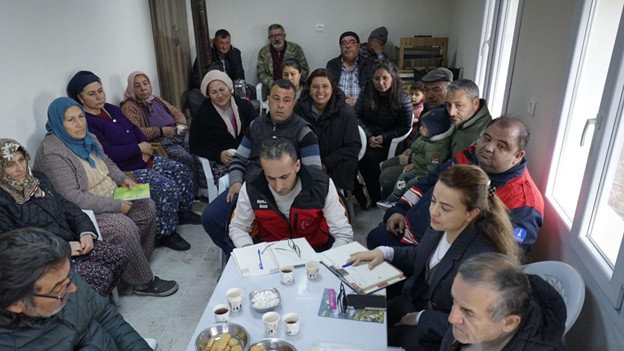
Officials from the İzmir Municipality Fire Department’s Forest Villages and Rural Area Fire Response Branch Directorate meet with the village head and villagers of Yerlitahtacı village in Bergama to discuss forest fire prevention efforts. February 11, 2025. Photo: İzmir Municipality Fire Department Press Unit.
Yaşar Korkmaz, Şerife Güzel, and their teams have taken significant steps toward recognizing and valuing women’s labor. They have gathered important insights, such as how women shepherds possess deep knowledge of the land, how women village heads can mobilize all segments of their villages, and how rural women contribute daily by clearing dry grass around their homes to reduce fire risk.
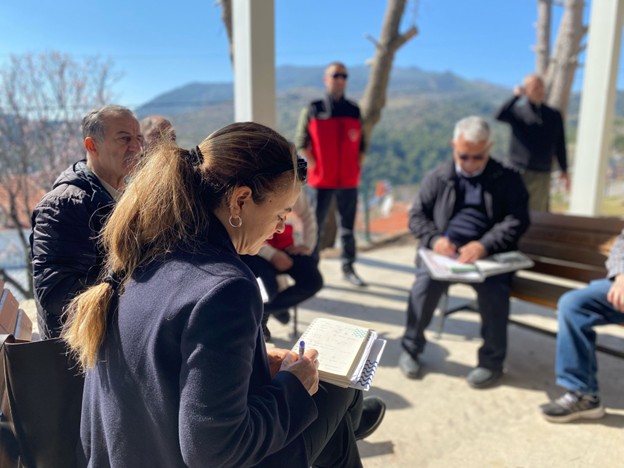
Officials from the İzmir Municipality Fire Department’s Forest Villages and Rural Area Fire Response Branch Directorate meet with the village head and villagers of Bergama Yerlitahtacı village to discuss forest fire prevention efforts. March 5, 2025. Photo: İzmir Municipality Fire Department Press Unit.
During our conversation with Sevil Duman, the village head of Urla Birgi village, we learned that, thanks to the water tanks they received from the municipality and the General Directorate of Forestry, she and her husband Kemal Duman, along with other concerned villagers, have been operating almost like an informal fire coordination center. We saw the water tanks, kept just behind the muhtarlık (village administration office), ready for an immediate fire response—even in February. They told us that during the summers, instead of attending weddings or going fishing—a pastime they love—they stay on fire watch duty. They regularly patrol fire-prone areas with their water tanker, sometimes conducting preventive watering to reduce fire risks.
Sevil Duman has also been a pioneer in developing fire prevention methods. For instance, she invited shepherds from other villages to bring their cows and sheep to graze on the grass along the roadside. This natural method of fire prevention helps reduce dry vegetation that could fuel wildfires. She actively shares this practice with neighboring villages and fellow muhtars.
“In the past, fires spread more slowly because animals used to graze on dry grass. Now, there are far fewer animals and shepherds, but we stay in close contact with those who remain,” she explained.
Having grown up in the village and maintaining strong ties to the region, Muhtar Sevil has extensive knowledge of the names and exact locations of around a hundred wells scattered throughout the area, as well as the local names used for different parts of the forest land. She emphasized that this local knowledge is crucial for quick fire response and effective communication. Together with her husband Kemal Duman, they have frequently relied on this knowledge to reach fire sites and water sources quickly. Over the past two years, they have managed to contain nearly fifteen fires before they could spread.
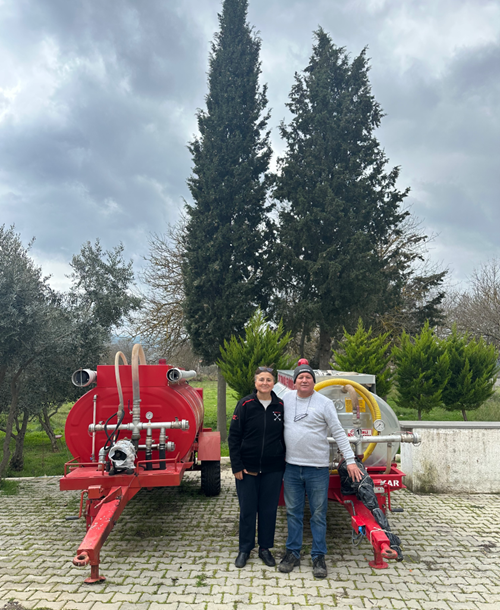
Urla Birgi Village Muhtar Sevil Duman and her husband Kemal Duman in front of the water tanks provided by Izmir Municipality Fire Department and the General Directorate of Forestry. February 23, 2025. Photo: Ayşe Gül Altınay
Şerife Güzel, Head of the Forest Villages and Rural Area Fire Response Branch of İzmir Fire Department, states that collaboration with women village heads creates a mutual space for empowerment. As a testament to this, on Friday, March 7, 2025, they held a joyful March 8 celebration with the women village heads to whom they had distributed water tanks.
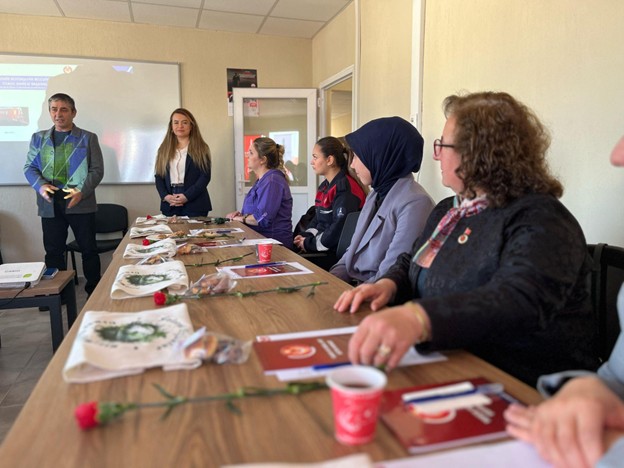
Plaque Ceremony and March 8 Celebration for Women Muhtars by Izmir Fire Department
Standing: Fire Department Head Yaşar Korkmaz and Head of the Forest Villages and Rural Area Fire Response Branch, Şerife Güzel. March 7, 2025. Photo: Izmir Fire Department Press Unit.
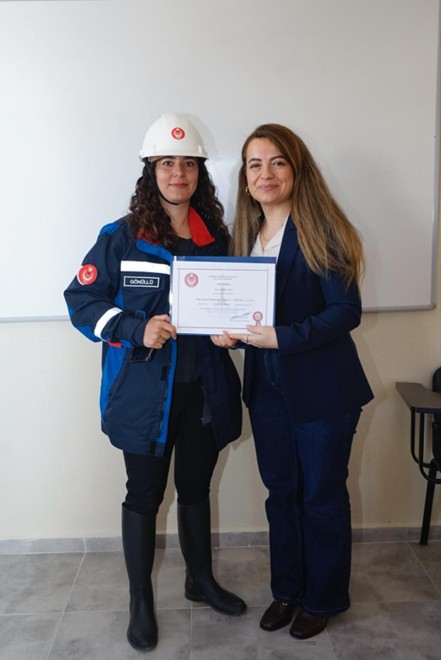
March 8 Celebration at Izmir Fire Department, featuring Branch Manager Şerife Güzel and Güzelbahçe Çamlı Village Head Ebru Gün. March 7, 2025. Photo: Izmir Fire Department Press Unit.
Whether this event, reminding women villageheads who play an active role in firefighting that they are not alone, will pave the way for the establishment of a solidarity network that enables more effective intervention in fires, only time will tell. What we can say, based on our research in Turkey and beyond, is
that the active participation of women, who have deep knowledge of their local geography (and all its human and more-than-human inhabitants) l and have the will, experience, and potential to establish strong collaborations across different sectors, is an important step toward making fire prevention and intervention mechanisms more inclusive and effective.
The Turkish version of this text is published here.
[1] For a policy recommendation addressing the importance of integrating indigenous and local knowledge into disaster intervention mechanisms, please refer to: Gajdusek, M. F., Düzel, E., Borhan Türeli, B., Green, K., Zorell, C., Altınay, A.G., Szüdi, G. (2024) ACCTING factsheet: “Valuing Indigeneous and Local Knowledge in Disaster Management and Nature Protection” https://zenodo.org/records/10490494
[2] For a policy document addressing the important role of women and civil society organizations working with an inclusive feminist approach in crisis management, please refer to: Altınay, A. G., Türker, N., Ensari, P., Tzanakou, C., Strid, S., Belloso, M. L., & Harroche, A. (2023). RESISTIRÉ factsheet: Crisis as a Continuum: Learning from an Inclusive Feminist Response https://zenodo.org/records/8056472
About the authors
 Esin Düzel is a Project Specialist for the EU Horizon 2020 project ACCTING, at Sabancı University´s Gender and Women´s Studies Excellence Center, and an anthropologist with a PhD from University of California, San Diego. Her work is concerned with affect, morality, and body in wars and conflicts, feminist and everyday peace, and future studies (with a focus on utopias, disasters, and biodiversity). She lives in Helsinki, Finland.
Esin Düzel is a Project Specialist for the EU Horizon 2020 project ACCTING, at Sabancı University´s Gender and Women´s Studies Excellence Center, and an anthropologist with a PhD from University of California, San Diego. Her work is concerned with affect, morality, and body in wars and conflicts, feminist and everyday peace, and future studies (with a focus on utopias, disasters, and biodiversity). She lives in Helsinki, Finland.
 Ayşe Gül Altinay is former Director of Sabancı University Gender and Women’s Studies Center of Excellence (SU Gender), Istanbul. Having published extensively on militarism, gender-based violence and gendered memories of war and political violence, Altınay’s current research focuses on feminist+ solidarity and transformative activism.
Ayşe Gül Altinay is former Director of Sabancı University Gender and Women’s Studies Center of Excellence (SU Gender), Istanbul. Having published extensively on militarism, gender-based violence and gendered memories of war and political violence, Altınay’s current research focuses on feminist+ solidarity and transformative activism.
 Burcu Borhan Türeli is a researcher and project specialist for the EU Horizon 2020 ACCTING project and works at Sabancı University. She has worked at various national and international universities. Her research interests include children’s literature, education and pedagogy, rural gender transformation, agri-food relationships, food security and sustainable food systems. She lives in Çanakkale, Turkey.
Burcu Borhan Türeli is a researcher and project specialist for the EU Horizon 2020 ACCTING project and works at Sabancı University. She has worked at various national and international universities. Her research interests include children’s literature, education and pedagogy, rural gender transformation, agri-food relationships, food security and sustainable food systems. She lives in Çanakkale, Turkey.

